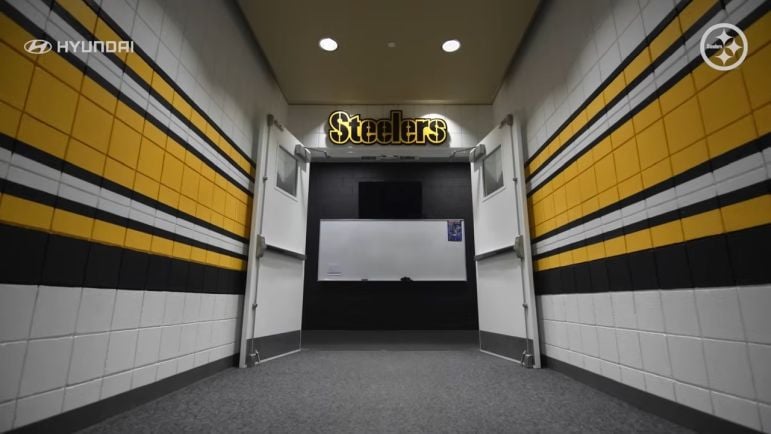The Pittsburgh Steelers have played 92 NFL seasons, their 93rd starting in just a few months. There have been highs, lows, and everything in between. In a new series we’ll use to pass the time of the offseason, I’m ranking all of them. From the worst season in franchise history to the best, which means picking which of the six Super Bowl winners came out on top. Not an easy task.
We’ll break this series down into parts (roughly) 10 at a time, working from worst to best, with one small caveat. I won’t be including the team’s two merger years, 1943 and 1944, when Pittsburgh combined with the Philadelphia Eagles and Chicago Cardinals due to a player shortage resulting from WWII. Since these were merger years where Pittsburgh wasn’t entirely its own entity, they fall into a separate category. We will rank the other 90.
Part One – Worst Of The Worst
Part Two – Not The Worst, Far From Best
Part Three – Total Stagnation
Ranking Every Steelers Season (No. 60-51)
60. 1998 season (7-9 record)
The ’98 season got off to a promising start. Pittsburgh started 3-1 and even climbed to 7-4, keeping playoff hopes high as the year hit the homestretch. But the Steelers completely collapsed in similar fashion to 2024, losing their final five regular-season games to finish the season below .500. Pittsburgh was held in single-digit points across three of those final four games, the only exception a 25-24 defeat to a Cincinnati Bengals collection that entered the game 2-12, sweeping Pittsburgh in the season series to net two of their three wins that year. Pathetic.
Quarterback play was an issue all year. Combined, Kordell Stewart and Mike Tomczak threw 13 touchdown passes to 20 interceptions, Stewart responsible for all 16 starts. Only two Steelers had at least 300 receiving yards. The running game was a bright spot with Jerome Bettis going for nearly 1,200 yards but it wasn’t enough. A top-10 scoring defense couldn’t save-face either.
While the defense kept scores down, the sack production wasn’t there. EDGE Jason Gildon was the only player with more than four. Offensively, center Dirt Dawson was named All-Pro for the final time of his career.
Pittsburgh ranked 28th out of 30 teams in scoring offense and ended the year with a minus-40 point differential.
Notable: WR Courtney Hawkins set the team’s long-standing franchise record for receptions in a game, catching 14 passes in a loss to the Tennessee Oilers. That broke J.R. Wilburn’s 12 reception mark set way back in 1967.
59. 1971 season (6-8 record)
More signs of progress in those early years under Noll. By 1972, the plan would come together. But Pittsburgh needed to suffer one more below-.500 season. The Steelers finished 17th in offensive and defensive scoring. QB Terry Bradshaw continued to be an interception machine, tossing 22 of them compared to 13 touchdowns. The offensive pieces were still on their way: RB Franco Harris along with WRs Lynn Swann and John Stallworth were still in college while RB/FB Rocky Bleier had just returned from his war wound and barely played.
Pittsburgh went on just one winning streak all year, victories in Weeks 2-3, but still showed improvement. The team swept the Cincinnati Bengals and beat the Cleveland Browns to show life in the AFC Central.
Still, there were growing pains. The Kansas City Chiefs blew Pittsburgh out 38-16 on Monday Night Football, the second year of the primetime slot’s existence. Worse, the Steelers blew a 21-3 lead to the Miami Dolphins in Week 9, falling 24-21 as WR Paul Warfield scored three times, including on a pair of 60-plus yard touchdown passes from Bob Griese. It’s tied for the biggest blown lead in franchise history.
Defensively, DL L.C. Greenwood clocked in at 11 sacks but was snubbed from a Pro Bowl selection. DT Joe Greene and LB Andy Russell got nods instead while rookie LB Jack Ham made an immediate impact with a pair of interceptions.
Notable: Despite outgaining the Chicago Bears 352-141 yards in the season opener, Pittsburgh lost 17-15. Seven Steelers turnovers was the counterbalance to their yardage advantage. Bradshaw threw four interceptions and the team lost three fumbles.
58. 1952 season (5-7 record)
The record isn’t pretty but remains two games under .500 like the two squads above. The difference is in point differential. In 1952, Pittsburgh had a positive finish, plus-27, for only the fourth time to date in franchise history. Five of the team’s losses came by one score, including some nailbiters: 21-20 to the Cleveland Browns in Week 2 and 29-28 again to the Browns in Week 8.
Pittsburgh secured its biggest win in franchise history this year, clubbing the New York Giants 63-7. The Steelers forced nine turnovers, QB Jim Finks threw four touchdown passes, and RB/RET Lynn Chandnois ran back an early kickoff for a touchdown. The team never looked back. The Giants weren’t even a bad team back then, entering the matchup 6-3.
After getting off to an ugly 0-4 start, the Steelers rallied the rest of the way. In the regular-season finale, Pittsburgh fell to the Los Angeles Rams 28-14 to fall shy of .500.
In the first year running the T-formation instead of the outdated Single Wing (Pittsburgh was the NFL’s last team to make the switch), Finks tied Otto Graham with 20 touchdown passes. He also finished third leaguewide with 19 interceptions. The running game didn’t offer much, end Ray Mathews “led” with 315 yards, but TE Elbie Nickel had a bang-up year with 55 receptions, 884 yards, and nine touchdowns in a justly-deserved Pro Bowl campaign. Finks, Mathews, and Chandnois also made the Pro Bowl and Pittsburgh for really the first time had a truly potent offense, finishing fourth in scoring.
Defensively, CB Jack Butler intercepted seven passes in the early portions of his Hall of Fame career.
Notable: Pittsburgh’s offense finished with exactly 300 points, a franchise-first. They wouldn’t cross that mark until 1962, then under a 14-game format. The Steelers’ 25 points per game was the team’s best mark until 1975, the team’s second Super Bowl run, when they averaged 26.6 points per game.
57. 2013 season (8-8 record)
A year that set a dreadful tone with an 0-4 start. It’s also the last international game Pittsburgh has played; at least until the Steelers host this year’s Dublin game. Like 2025, the opponent back then was the Minnesota Vikings. A jet-lagged Steelers team fell short of a comeback bid, falling 34-27.
Pittsburgh bottomed out to 2-6 after an awful 55-31 loss to the New England Patriots, the most points the Steelers have ever allowed in a single game. The 610 yards allowed also remains a franchise worst. Heartbreak intensified after Antonio Brown nearly beat the Miami Dolphins on a wild lateral play down the left sideline but he narrowly stepped out of bounds on his way to the end zone. The defeat put Pittsburgh at 5-8.
The Steelers rattled off three-straight victories to close out the year, including divisional wins over the Cincinnati Bengals and Cleveland Browns to finish second in the AFC North. Making the playoffs was possible even in Week 17 but a win by the San Diego Chargers over the Kansas City Chiefs officially eliminated them.
This was RB Le’Veon Bell’s rookie season. Despite missing the first three weeks with an ankle injury, he still managed nearly 1,300 all-purpose yards with eight rushing scores. Antonio Brown broke out as a receiver, one yard shy of a 1,500-yard season, and a Pro Bowl accolade. Defensively, EDGE Jason Worilds led the team with eight sacks but the defense finished with just 10 interceptions.
The year served as a swan song of sorts for safeties Troy Polamalu and Ryan Clark. A dynamic duo nearing the end of their careers, Clark left in the offseason and Polamalu spent just one more season with the team. It’s fair to rank this year even worse than I’ve placed it.
Notable: Pittsburgh failed to record a takeaway over its first four games of the year, all losses. The first didn’t come until after the Week 5 bye, picking off QB Geno Smith twice in a 19-6 win.
56. 1957 season (6-6 record)
An old-school version of 2019 that you’ll soon see on this list. Great defense, horri-bad offense. Pittsburgh ranked second in scoring defense (14.8 PPG) but last in scoring (13.4 PPG). The offense was held under 10 points in five of 12 games while turning it over at least four times in five contests. Earl Morrall served as the team’s starting quarterback, throwing 11 for touchdowns, while Billy Wells is a forgotten leading rusher. He finished with 532 yards. End Jack McClairen led the team in receiving and made the Pro Bowl but this was a forgettable year with names lost to time.
Cornerback Jack Butler had the most memorable season, leading the NFL with 10 interceptions. He was named first-team All-Pro.
Pittsburgh was competitive for the first half of the season, sitting 4-2 after Week 6, but dropped four of its final six to finish .500.
Notable: Pittsburgh beat the Chicago Cardinals 27-2 in the regular-season finale. It was the first and remains just the second occasion the Steelers have allowed exactly two points in a game – 1972 against the San Diego Chargers is the other. The Cardinals’ points came on an errant Steelers punt where the snap sailed out of the end zone.
55. 2012 season (8-8 record)
A season that skidded to the finish. Pittsburgh spoiled a 6-3 start by losing five of its next six, including an overtime defeat against the Dallas Cowboys. For the first and, to date, only time under Mike Tomlin, the Steelers played a meaningless game. Eliminated from playoff contention after a Week 16 loss to the Cincinnati Bengals, Pittsburgh finished .500 with a finale win over the Cleveland Browns. But it was little consolation to a year that went up in smoke.
The offense finished a lowly 22nd in scoring while the defense ranked sixth. RB Jonathan Dwyer led the team rushing but still managed just 623 yards while Antonio Brown regressed and missed time with injury. Pittsburgh’s defense didn’t allow many points but failed to provide much splash, registering 37 sacks and 10 interceptions.
A low point came during a Week 12 loss to the then 2-8 Browns. Pittsburgh turned the ball over eight times – QB Charlie Batch threw three picks while RBs Isaac Redman, Jonathan Dwyer, Chris Rainey, and Rashard Mendenhall along with WR Emmanuel Sanders fumbled the ball away. Since the merger, it’s one of just five games in which Pittsburgh has turned it over eight or more times. It was the team’s first since 1989.
Notable: A 34-year-old James Harrison tied Lawrence Timmons for the team lead with six sacks. He would leave for the Cincinnati Bengals in the offseason.
54. 1953 season (6-6 record)
A .500 record but minus-52 points differential with below-average marks on both sides of the ball. Pittsburgh began the season 2-1 with wins over the New York Giants and Chicago Cardinals. But the team lost to the Philadelphia Eagles in two of the next three weeks and the Steelers remained at or below .500 the rest of the season. Pittsburgh won its final two games to end 6-6.
QB Jim Finks regressed from his 1952 campaign, throwing for just eight touchdowns to 14 interceptions. The offense as a whole finished with more rushing (13) than passing (10) scores. Athlete Lynn Chandnois was a multi-purpose threat and Pro Bowler, a bright spot on the year. Offensive lineman George Hughes made his second and final Pro Bowl.
Notable: To capture that final regular-season win over the Washington Redskins, CB Jack Butler intercepted four passes. That remains a Steelers single-game franchise record. Since 2000, only two NFL players, Deltha O’Neal and DeAngelo Hall, have picked off four passes.
53. 2019 season (8-8 record)
What a year 2019 was. Great defense, dog-turd offense. It’s hard to blame Pittsburgh for it. QB Ben Roethlisberger was lost six quarters into the season, forcing the team to rotate between Mason Rudolph and Duck Hodges the rest of the year. The Steelers’ only regret might’ve been trading Josh Dobbs days before Roethlisberger went down.
Trading for FS Minkah Fitzpatrick shortly after, the defense assumed the mantle of needing to win every game. At times, it was Pittsburgh’s best offense, scoring three defensive touchdowns. The Steelers finished fifth in points allowed, only allowing 28 points once over their final 11 games. Not exactly 1976 but impressive for the times. T.J. Watt and Bud Dupree posted double-digit sacks with DT Cam Heyward one shy of joining them. Collectively, Pittsburgh recorded 53 sacks. CB Joe Haden and Fitzpatrick tied for the team lead with five picks as the Steelers finished with 20. It was defensive dominance.
The offense? Not so much. Roethlisberger’s elbow injury was the headliner but hardly the only one. RB James Conner, WR JuJu Smith-Schuster, and rookie WR Diontae Johnson all missed action. At times, RB Kerrith Whyte Jr. and WR Tevin Jones saw offensive playing time. No Steeler finished with even 500 rushing yards. WR James Washington led the team in receiving.
Despite all the obstacles, Pittsburgh rose to the moment and late in the year sat at 8-5 with the playoffs in sight. But the dam broke and the Steelers dropped their final three games, including a slopfest to the Baltimore Ravens in a finale they were eliminated in before the clock hit zero.
Mason Rudolph got knocked out by Baltimore and then again by Myles Garrett. Assault. It was a weird season.
Notable: In a show of just how many players saw the field, 18 different Steelers caught a pass in 2019. And 12 of them carried the ball at least once. Names in those camps include WR Johnny Holton, RB Tony Brooks-James, and WR Deon Cain.
52. 1985 season (7-9 record)
A negative record but positive point differential. Pittsburgh blew out the Indianapolis Colts 45-3 in the season opener, outgaining the opposition 445-159 with 30 offensive first downs. Two weeks later, the Steelers shut out the Houston Oilers, 20-0. But a 2-1 start gave way to a three-game losing streak and four of the team’s next five, dropping the Steelers’ record to 3-5. A three-game rally put Pittsburgh above .500 before another three-game losing skid put the nail in the year’s coffin. A season of streaks.
One defeat ended in the highest-scoring game in franchise history, 54-44 to the San Diego Chargers on a Sunday night in December. A loss to the New York Giants in the finale kept Pittsburgh below .500.
Quarterbacks Mark Malone and David Woodley split time. Malone had the better numbers (13 TDs/7 INTs to Woodley’s 6 TDs/14 INTs), but Woodley had the better record (4-2) versus Malone (3-5). Scott Campbell started a pair of games, losing both. RB Frank Pollard fell nine yards shy of 1,000. WR Louis Lipps shined with more than 1,100 receiving yards and second-team All-Pro selection. He also returned two punts for touchdowns. C Mike Webster and LB Mike Merriweather made the Pro Bowl while K Gary Anderson led the NFL with 33 field goals.
It was an ugly division, and one the Steelers could’ve easily won. While they technically ended third, they tied the Cincinnati Bengals with a 7-9 record behind division winner, the 8-8 Cleveland Browns.
Notable: Cleveland won the AFC Central with a negative point differential while the Steelers’ plus-24 was the division’s best mark.
51. 1987 season (8-7 record)
Record isn’t a typo. The NFL navigated a strike, marking the last time regular-season action was lost due to one. At separate points of the season, Pittsburgh sat two games above .500 and even 8-5 in mid-December but lost the final two weeks to the Houston Oilers and Cleveland Browns.
QB Mark Malone and the passing game were an eyesore as the Steelers bounced between wins and losses. Malone threw six touchdown passes to 19 interceptions. Add in Steve Bono’s three starts and Pittsburgh threw fpr 13 scores to 25 picks. Bad all around.
Earnest Jackson led Pittsburgh in rushing yards but had just one score. In his final year at age 35, John Stallworth was the only Steeler above 325 receiving yards and 25 receptions. Only Mike Webster made the Pro Bowl.
Defensively, the Steelers finished 10th in scoring but picked up a lowly 26 sacks. Notable strike players included WR Joey Clinkscales and K David Trout, who hadn’t kicked for Pittsburgh or any NFL team since 1981. In three games, he made 10 extra points but missed both field goal attempts.
Notable: QB Reggie Collier had only seven pass attempts but made them notable. Two went for touchdowns, one was intercepted, and an eighth drop back saw him sacked. Since the merger, only two quarterbacks have thrown for two scores and one pick on 10 or fewer attempts. Collier is one, the Miami Dolphins’ Jim Del Gaizo is the other during the team’s perfect 1972 season.
Ranking Steelers’ Seasons (Recap)
90. 1941
89. 1965
88. 1934
87. 1939
86. 1969
85. 1940
84. 1945
83. 1968
82. 1938
81. 1988
80. 1933
79. 1955
78. 1935
77. 1967
76. 1964
75. 2003
74. 1951
73. 1937
72. 1948
71. 1936
70. 1970
69. 1986
68. 1991
67. 1966
66. 1999
65. 1954
64. 1956
63. 1960
62. 1950
61. 2022
60. 1998
59. 1971
58. 1952
57. 2013
56. 1957
55. 2012
54. 1953
53. 2019
52. 1985
51. 1987








